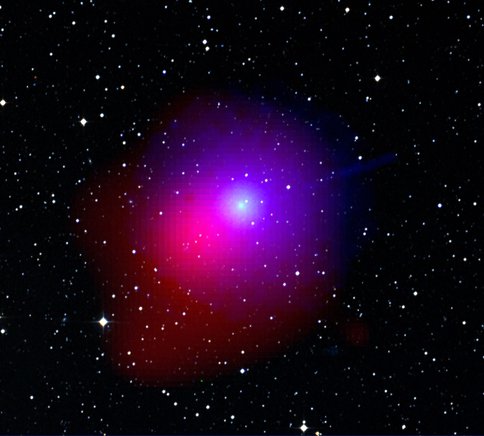2010 Annual Science Report
 NASA Goddard Space Flight Center
Reporting | SEP 2009 – AUG 2010
NASA Goddard Space Flight Center
Reporting | SEP 2009 – AUG 2010
High Energy Observations of Planets and Comets
Project Summary
We used the Swift high-energy mission to acquire UV spectroscopy of several comets, amongst which comet 81P/Wild-2 (the target of the Stardust mission) and comet Lulin. These data allowed us to derive gas production rates of OH (water) as well as various organic species that cannot easily be observed from Earth.
Project Progress
Comets: I have used the Swift observatory to study several very interesting comets (C/2007 Lulin, 81P/Wild-2). Swift’s UV-optical grisms have not been extensively used before these campaigns. The spectral ranges of UVOT grisms (175-520 nm) encompass known cometary fluorescence bands such as CO2+ (280 nm), OH (306 nm) (OH is the principal photolysis product of H2O), native CO (140-180 nm), and of many other molecular fragments (e.g., NH, CS, CN, C2, fragment CO, etc.). Repeated observations of the two comets with Swift’s UV-Optical Telescope (UVOT) provided a unique dataset that reveals variations in the comet’s gas production rate on a scale of hours as well as months. As part of this investigation, much time and effort was dedicated to developing new analytical routines for processing the grism data. I am now analyzing the extracted cometary spectra and will prepare the results for publication in the refereed literature. I requested Swift observations for those comets and played the lead role in this research.
Exoplanets: I have started an extensive campaign to study the interaction between exoplanets and their host stars. I intend to assess stellar activity and its impact on close-in planets using X-ray and optical observations. I requested observations with the XMM-Newton telescope and different ground based observatories, and will investigate how stars can act as a source of erosive particle and electromagnetic radiation impacting the planet.
Figure 1. First simultaneous observations of a comet in X-ray and UV. Comet Lulin’s close approach to Earth allowed us take a unique image combining Swift’s X-ray and UV telescopes, usually intended to observe gamma-ray bursts. The data are combined here, along with a sky survey image of background stars, to show optical and ultraviolet light in green-blue hues and x-rays from the comet in red. The result maps remarkable x-ray emission on the comet’s sunward side as incoming solar wind ions interact with gases in the swollen coma. It also shows substantial ultraviolet emission opposite the Sun, in the direction of motion and the comet’s tail. The ultraviolet emission is from the OH molecule derived from the breakup of water, an indicator of the copius amounts of water produced by this extremely active comet. Using the telescopes grisms to acquire UV spectra of the comet we measured the comet’s organic composition and water production rates
First simultaneous observations of a comet in X-ray and UV. Comet Lulin’s close approach to Earth allowed us take a unique image combining Swift’s X-ray and UV telescopes, usually intended to observe gamma-ray bursts. The data are combined here, along with a sky survey image of background stars, to show optical and ultraviolet light in green-blue hues and x-rays from the comet in red. The result maps remarkable x-ray emission on the comet’s sunward side as incoming solar wind ions interact with gases in the swollen coma. It also shows substantial ultraviolet emission opposite the Sun, in the direction of motion and the comet’s tail. The ultraviolet emission is from the OH molecule derived from the breakup of water, an indicator of the copius amounts of water produced by this extremely active comet. Using the telescopes grisms to acquire UV spectra of the comet we measured the comet’s organic composition and water production rates.
Publications:
1. D. J. Christian, D. Bodewits, C.M. Lisse, K. Dennerl, S. J. Wolk, H. Hsieh, T.H. Zurbuchen, and L. Zhao, ‘Chandra Observations of Comets 8P/Tuttle and 17P/Holmes during Solar Minimum’, ApJS, 174, 447 (2010)
2. S.J. Wolk, C.M. Lisse, D. Bodewits, D. J. Christian, & K. Dennerl, ‘Chandra’s close encounter with the disintegrating comets 73P/Schwassmann-Wachmann-3 Fragment B and C/1999 S4 (LINEAR)’, ApJ. 694 1293 (2009)
Publications
-
Christian, D. J., Bodewits, D., Lisse, C. M., Dennerl, K., Wolk, S. J., Hsieh, H., … Zhao, L. (2010). CHANDRA OBSERVATIONS OF COMETS 8P/TUTTLE AND 17P/HOLMES DURING SOLAR MINIMUM. The Astrophysical Journal Supplement Series, 187(2), 447–459. doi:10.1088/0067-0049/187/2/447
-
PROJECT INVESTIGATORS:
-
RELATED OBJECTIVES:
Objective 3.2
Origins and evolution of functional biomolecules
